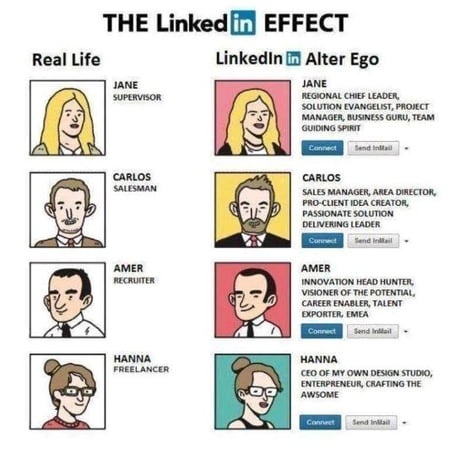
If you are ever on Linkedin, which you should by now, you may realize this interesting phenomenon. Suddenly, everyone seems to have a super high profiled job. They seem to have a whole list of superpowers in which they can do in their careers and have also brought to their companies irreplaceable accomplishments etc. And maybe, that has intimidated you.
You might think to yourself, you too, need to showcase yourself as a superstar.
So if you are a full stack developer, should you go all out to oversell yourself too? Maybe call yourself a “full stack developer expert”, and that could help you stand out from the crowd?
The answer to that is a 100% NO.
In fact, right now, promise to never ever use these buzzwords to describe yourself on LinkedIn.
These exaggerated profiles have been seen too often on LinkedIn, and there is even a term for this phenomenon, called the LinkedIn Effect.
What is The LinkedIn Effect?

As we all know, LinkedIn is essentially a dating app for recruiters to connect with potential employees. Because of this, many individuals want to create an image of themselves to be seen as “attractive” to get the job positions they are looking for.
However, as much as this may seem like perfect self-marketing, experienced recruiters are also very well aware of this effect and would be able to tell the difference between real, genuine talents from the other overly sold profiles.
So How Should You Position Yourself on LinkedIn?
Buzz words and adjectives like “experts” or “guru” should never ever be used to describe yourself on your LinkedIn profiles. When a recruiter or a potential employer sees these descriptions, they would definitely be turned off.
A self-acclaimed “expert” has basically zero value and just makes you come off as someone who is tooting their own horn, and most probably do not have much real career achievements; so much so that need to build a professional sounding description without actually sharing about their real experiences.
When you are positioning yourself on LinkedIn, don’t focus on creating a nice sounding “label” for yourself. Instead, think of what actually brings value to your potential employee. For example, if you are looking to become a full stack developer, don’t just focus on showing off your technical skillsets. Instead, showcase your experiences and how you helped your previous clients or companies achieve what they needed to.
Remember, LinkedIn is a platform where employers and recruiters are looking for people that can actually fill the role in the company and get the job done, and not to find a trophy individual that has a superb sounding profile, and yet is not able to produce substantial results.
LinkedIn Basics: The key points you need to include in your profile:
1. A Professional Profile Photo

As I am writing this, the emphasis is on the “professional”. This is not to say you have to be in a suit and tie for the photo, but rather, you need to at least be wearing something to which is appropriate to your industry. Get a photo that is of high resolution, with your face seen clearly, and best for the background to be in a working setting if possible.
Also, selfies and group photos are a big no-no, as it comes off as if you are not serious about building your own image, and may even confuse the potential employee as to which one of the person in the group photo is you. The first thing that people look at on a profile is usually the photo. So that gives off the very first impression of yourself.
2. Don’t Make Your Profile A Copy of Your Resume
When you are writing your LinkedIn Profile, don’t just make it an exact copy of your resume. On LinkedIn, you are able to be a little bit more flexible, and express yourself more freely. Again, keep in mind that LinkedIn is a social network.
For example, when you are writing your headline, don’t just write your position title or your job summary. Instead, write an interesting one-liner headline that describes yourself, and how you are unique from the rest of the other full-stack developers out there.
Another good addition to your summary of describing yourself and the work you do is to always include a section about where you want to go in terms of your career in the future.
These might not be information that you can just slot into your resume, but on your LinkedIn profile, it’s always good to give an indication of your career goals and where would you see yourself expanding towards, so recruiters can see if your goals are aligned with the role they are looking for.
3. Change your Profile URL
A really simple step that takes you less than a minute, to switch up how professional your profile, is to customise your LinkedIn URL to your full name.
This way, when you are linking it to your resume or when people are looking for you on LinkedIn, your profile would be much easier to access, and it shows how serious you take your professional image. Now that you got the basics covered, we will dive in into the X factors that will help you stand out as a full stack developer on LinkedIn.
How to Make Your LinkedIn Profile Stand Out:
1. Highlight Your Experiences

Again, like all job application platforms, your experience is worth way more than anything else. Utilise the description section for each role you were in, and write concise paragraphs or point forms (people have a very short attention span, even more so online) of the qualitative and quantitative accomplishments you have brought to that specific job role.
If you worked on a mobile app development project, mention what you helped to build, what accomplishments you achieved, the problems you solved, the technical skillset you utilised and your thought process behind the project
Many people do not do this. But with this, not only the potential recruiter can get a better sense of your capabilities in specific tasks, and he or she can also connect towards your personality.
Here is a pretty good example:
I spearheaded a team to write and style the front-end components that meet the requirements for our MVP before the product launch.
Once the product was launched, I led a team of 4 to create a full-fledged app that successfully helped to reduce the turnover rate by 35%.
Technologies used:
– Angular, JavaScript, ES6, TypeScript, SASS
This way, anyone who visits your profile can straightaway tell what you technical skillsets you have, and how efficient you are at solving business problems.
2. Recommendations & Endorsements

Another benefit of using LinkedIn is how there is a section where other people can provide you with recommendations & endorsements.
Just like any other products or services, one that comes with good feedback and reviews makes a person trust the brand more. When there are other people further endorsing you for the relevant skills, it will surely make you stand out among the other applicants.
It takes conscious effort to have recommendations and endorsement, so when someone actually compliments you on a job well done, ask them if they are okay to write you a LinkedIn recommendation or endorse a certain skill. They will be more likely to write you one then as compared to you asking them after a long time has passed.
3. Make significant connections
The biggest difference between LinkedIn and any other resumes or cover letters is that this online platform allows you to make connections. Hence, take full advantage of this and make significant connections.

Be it with people of the same industry, or people you have worked with, it is very important for you to use LinkedIn as a virtual business networking platform.Even if you do not personally know a person, genuinely reach out to them to form business connections and send them a personalised message.
As you do this, always look at ways to add value to them. Find out what they need and what they would aspire to have.
However, note that LinkedIn is not a friendly social network like Facebook for you to chat up anyone. Do that and risk being labelled as like a creep. And that is not what you want on a professional platform like LinkedIn.
4. Publish Your Own Content

This one is an optional one, but, something that can instantly help you stand out from the crowd.
If you enjoy writing or have some ideas or insights to share about your industry, share it on LinkedIn. Even if you are not a writer, don’t overthink on the writing skills. Focus on getting your message across in a simple, clear and easy to understand way, and write content that would be able to express your opinions and thoughts on the work that you do.
If a recruiter sees that you are passionate enough to write about work-related topics, your chances in being hired might just be higher.
Conclusion:
LinkedIn is not a platform for you to just use buzzwords to show off what your position, but rather, it is rather a professional platform to share your work experiences and how you can add value to your potential companies.
Alright, that’s it! We hope this guide will help give you a better idea of creating an awesome LinkedIn Profile to get the job you want.
At LEAD, we emphasize a lot on building your network. That’s why all our students get access to our very own community, made up of people in data science, web development, digital marketing and business.
Remember, when you join a community or public group – always think about how you can add more value to the group.
Because it’s no longer about who you know, rather, who knows you.
If you are interested to be a part of the LEAD family, do check out our programs HERE.


0 Comments